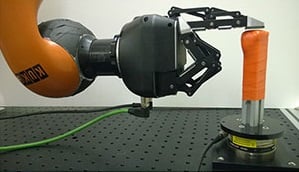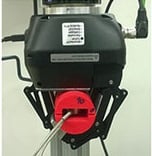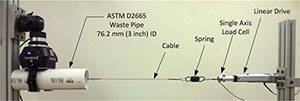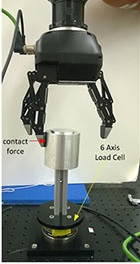Robot Gripper Metrics Studied at NIST

Posted on Apr 02, 2015 in Robot Grippers
6 min read time
If you are already using a robot gripper you may have been through the selection process for the gripper. This can be a very complex process since every company has its very own way to market its grippers and to present their data in the best light for them in order to have an advantage over their competitors. Let's be honest this is just how free and open markets work! But it doesn't necessarily help you to analyze all the data you have to review. So, to help the end-user with this data the National Institute of Standards and Technology (NIST) has decided to test a couple of different grippers to establish some robot gripper metrics. These metrics should help you to decide which end-effector will best suit your application according to the capabilities of the gripper and the needs of your application. The following article describes the different tests that have been done on the selected grippers.
Before going too far into the explanation of the testing process you should notice that the results are not associated with a specific robot trademark. In other words don't try to associate a particular result to a particular gripper... we don't even have the results for our own Gripper. Anyway, the metrics are still in development and the final results will be posted sometime soon, so hopefully these tests will in the near future help you to be able to associate which grippers meet which applications best.
Metric Description
In order to design relevant performance metrics and methods for characterizing robotic hands, it helps to understand the issues surrounding robotic grasping and manipulation. Regardless of the actual task at hand, any grasping and manipulation problem can be broken down into the following two principles, kinematics and kinetics, or more simply, motion and effort. Candidate entities of interest include palms, fingers, points of contact, or parts under grasp. Building test methods from these fundamental points of view will ultimately lead to relevant performance measurements.
Kinematics is the geometry of motion of bodies or particles with complete disregard for the forces that cause such motion. Therefore, any kinematic metric or test method will be concerned with evaluating positions, velocities, or accelerations of bodies, parts, or particles, and will typically be in units of length and time.
Kinetics are the forces acting on bodies or particles that are responsible for causing their motion. In particular, any kinetic metric or test method will be evaluating force, torques, and any other measure of effort such as electrical current.
Performance Metrics
Here are the preliminary metrics that have been tested until now. For the moment we don't really know which grippers have been tested yet, however pictures shows that our gripper is used as an example.
Finger Strength

Finger strength is a kinetic measure of the maximum force a robotic finger can impose on its environment. This measure relates to the overall strength of the hand during grasping or manipulation capabilities. The reasons for measuring strength on a single finger basis are two-fold:
-
grasping and manipulation can occur with any number of fingers which means that the most independent measure of strength would be finger strength, and
-
there can be inherent variability in finger strength across different fingers even in cases where they are mechanically equivalent.
Grasp Strength

Grasp strength is a kinetic measure of the maximum force a robotic hand can impose on an object. This measure will yield information regarding a particular hand’s payload capabilities for different sized objects, as well as the limits to resisting pulling or pushing forces during a grasping operation. Notice that this metric is done with various part sizes to evaluate the capabilities of the gripper to apply constant force for various finger positions.
Slip Resistance
Slip resistance is a kinetic measure of a robotic hand’s ability to resist slippage. The focus of this metric is to investigate the inherent surface friction properties of the hand. With higher friction coefficients, robotic fingers will possess wider friction cones at the areas of contact with an object. This behavior would ultimately allow friction forces to contribute more greatly to the overall grasping effort yielding greater resistances to slipping, and generally enhanced energy efficiency during the grasping operation.

Touch Sensitivity
 Touch sensitivity is a kinetic measure of the smallest self-registered contact force exerted by a robotic finger on an object. The significance of this trait revolves around the hand’s ability to delicately interact with minimal disturbance to the immediate environment, as well as detect small force perturbations. Direct applications would include touch-based grasp planning, or part acquisition with object location or shape uncertainties.
Touch sensitivity is a kinetic measure of the smallest self-registered contact force exerted by a robotic finger on an object. The significance of this trait revolves around the hand’s ability to delicately interact with minimal disturbance to the immediate environment, as well as detect small force perturbations. Direct applications would include touch-based grasp planning, or part acquisition with object location or shape uncertainties.
Finger Force Tracking
Finger force tracking is a kinetic measure regarding the finger’s ability to impose desired contact forces on its environment. This capability is particularly important for many state-of-the-art robotic grasping and manipulation control algorithms that use force-based control approaches. Moreover, this capability can be used for touch-based grasp planning, controlled interaction for texture discrimination and object localization.
Sensor Calibration
Force based sensor calibration is important for many state-of-the-art robotic grasping and manipulation control algorithms that use force-based control approaches. That is, in order to control contact forces, force sensor readings must be accurate. Moreover, force capabilities can be used for touch-based grasp planning, controlled interaction for texture discrimination and object localization.
To have further information on this fascinating research visit the NIST website where you can see the different calculation methods and raw data. I suspect that a compilation of this data will be made public in the near future and hopefully this will mean that there will be a way to compare grippers in a more neutral and accurate manner. I am really looking forward to seeing the final results. As you may have notice the 3-Finger Adaptive Gripper is part of the study, if you want to see some applications that are already using our Gripper follow the link below.


.jpg)





Leave a comment